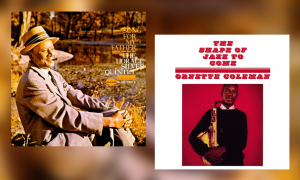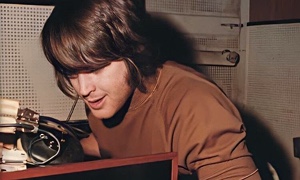Home » Jazz Articles » Building a Jazz Library » Michel Legrand: Hollywood Hitmaker And Jazz Genius
Michel Legrand: Hollywood Hitmaker And Jazz Genius

Jazz is the best of all nourishments. It feeds the creative spirit like nothing else can. It is a fantastic adventure, an exciting game of giving and taking and exchanging musical ideas. When the conditions are right, it is possible to achieve a level of rapport that is nowhere else to be found in art.
—Michel Legrand
Legrand began his career in Paris in the early 1950s, with one foot in chanson and the other in jazz. In the early 1960s, he was adopted by "nouvelle vague" (new wave) film directors such as Jean-Luc Godard and Claude Chabrol as a first-call composer and orchestrator. He went on to make a considerable fortune scoring Hollywood movies in the late 1960s through the 1980s, among them: The Thomas Crown Affair (1968), which included the megahit "The Windmills Of Your Mind," Summer Of '42 (1971), Atlantic City (1980) and Yentl (1983), among many more. In total, Legrand scored over 250 films and TV productions. He won three Oscars and five Grammys.
Born in 1932, Legrand passed in 2019. A modest, private man with a quiet sense of humour, he maintained parallel film and jazz careers until the end. His final appearance at London's Ronnie Scott's Jazz Club was in 2011, when he announced from the stage one night that it was his ambition to meet "one of the nineteen people who ever saw The Happy Ending," the 1969 Hollywood film for which he wrote his classic love song "What Are You Doing the Rest of Your Life?"
This survey of Legrand's recordings begins with a near-jazz EP released in France in 1954 and featuring the then Paris-based Blossom Dearie among the lineup...
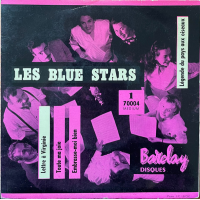 Les Blue Stars
Les Blue Stars Légende Du Pays Aux Oiseaux
Barclay EP, 1954
By 1954, aged just 22, Legrand was already in demand on the Paris scene as a pianist, arranger, composer and conductor, with an expanding catalogue of chanson projects. The jazz inflected Les Blue Stars, a close-harmony vocal octet of four women and four men, worked primarily as session singers, and the title track from this four-track EP, an upbeat French language cover of George Shearing's "Lullaby Of Birdland" arranged by Legrand, was a hit in France. The group's contralto was Blossom Dearie, who had moved to Paris in 1952, and the lead soprano was Legrand's sister, Christiane (later a founder member of the Swingle Singers). Some writers have suggested Dearie also played piano and conducted on Légende Du Pays Aux Oiseaux , but doing both those things and singing in the real-time recording age is unlikely. The pianist and conductor is more probably Legrand. In 2002, Gitanes Jazz Productions reissued all four tracks from the original EP as part of the Dearie compilation The Pianist, searching for which will bring up a YouTube of "Légende Du Pays Aux Oiseaux."
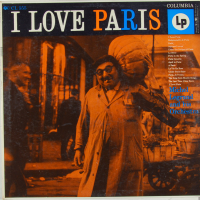 Michel Legrand
Michel Legrand I Love Paris
Columbia, 1954
The success of Légende Du Pays Aux Oiseaux will have been one reason Columbia hired Legrand to orchestrate and conduct this collection of chanson and French-themed classics for the American market. The music—sixteen songs which he arranged into a kind of suite—is easy listening but it is sophisticated enough to reward attention (and in 2023 works even better as a shot of retro). Legrand was paid $200, with no royalties, for the album and on the first pressing barely scraped a front of sleeve credit (it is below the track listing). But I Love Paris was a massive best seller and Legrand's international career never looked back. Follow-up Bonjour Paris, released by Columbia in 1957, is just as good. This time out Legrand gets a sleeve credit above the album title, and one imagines he would have negotiated royalties, too. Miles Davis is rumoured to have played on the session. This seems unlikely (and he is in any case unidentifiable). But it could just possibly be true: in the mid-1950s, Legrand worked as a pianist and arranger for Juliette Greco, with whom Davis began a passionate love affair, which never really ended, in Paris during the International Festival de Jazz in 1949. Greco may have made the introductions.
 Michel Legrand
Michel Legrand Legrand Jazz
Columbia, 1958
Davis definitely played on this, Legrand's first jazz masterpiece. Also featured: Phil Woods, John Coltrane, Bill Evans, Ben Webster, Donald Byrd, Art Farmer, Herbie Mann, Paul Chambers, Hank Jones, George Duvivier, Ernie Royal, Jimmy Cleveland and 21 other American a-listers (see * below), grouped in 10 to 15-piece ensembles recorded over three days in New York in June 1958. The US success of I Love Paris, and the mutual love existing between American jazz musicians and the Parisian jazz world, meant Legrand could assemble a New York lineup like no other. It is not, however, simply the presence of these musicians, or such unexpected and exalted solos as Davis' on Fats Waller's "Jitterbug Waltz" or Webster's on Django Reinhardt's "Nuages," to name just two of the many magic moments on the 11 jazz standards on the album, that make it one which every self-respecting jazz library has to include. Arguably more important is the way Legrand, as the arranger, gets inside each tune, revealing new facets and perspectives, and does so without ever losing hold of those elements that made each melody a classic to begin with. The other nine tracks are "Night In Tunisia," "Blue And Sentimental," "Stompin' At The Savoy," "Django," "Wild Man Blues," "Rosetta," "'Round Midnight," "Don't Get Around Much Anymore" and "In A Mist." Legrand Jazz is a work of conceptual genius which Legrand, probably sensibly, never attempted to repeat. (Legrand and Miles Davis worked together again in 1991 on the soundtrack for the Warner Bros movie Dingo, but the soundtrack album is for Davis and/or Legrand completists only).
* Among these a-listers was the emerging star, trumpeter Joe Wilder, who never quite fulfilled his career potential, despite appearing on a handful of stone classics in the 1960s, 1970s and and 1980s. These include Yusef Lateef's The Doctor Is In ...And Out (Atlantic, 1976) and, discussed below, Legrand's After The Rain (Pablo, 1983).
 Michel Legrand
Michel Legrand Paris Jazz Piano
Philips, 1960
Legrand's greatest contribution to jazz was undoubtedly as an arranger and composer, but his gifts carried over into his piano playing. This was far more accomplished than the "arranger's piano" of people such as Tadd Dameron or Billy Strayhorn, and was sometimes too technically facile for its own good. Paris Jazz Piano is an enjoyable early example. Legrand fronts a trio with bassist Guy Pedersen and drummer Gus Wallez on ten Paris-themed tracks. These include American-penned tunes, such as Cole Porter's "I Love Paris" and Vernon Duke's "April In Paris," and authentic chansons such as Leo Ferré's "Paris Canaille" and Louiguy's "La Vie En Rose." There are no Legrand originals. A palpable sense of place surrounds the music.
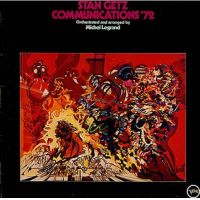 Stan Getz
Stan Getz Communications '72
Verve, 1972
On Communications '72, Legrand puts Stan Getz in front of a string ensemble, a vocal choir featuring Christiane Legrand, and a rhythm section led by organist Eddy Louiss. The closest comparator is not Getz's Eddie Sauter-arranged Focus (Verve, 1961), but rather the later What The World Needs Now (Verve, 1968), on which the material is a selection of Burt Bacharach tunes variously arranged by Richard Evans and Claus Ogerman. That was a good album that would likely have been better had Bacharach himself arranged it. Communications '72 is more successful in part because Legrand composed and arranged all of it, partly because the choice of material is thoughtful and diverse, and partly because Getz himself is deeply engaged. The tunes span "Outhouse Blues," on which Getz blows a dozen choruses of fervent, relentlessly escalating intensity, lustrous ballads, a tip of the hat to Bach and another, more astringent nod to Bartok. Getz rides the eventful and sophisticated arrangements like the maestro he was, by turns soaringly lyrical and fiercely declamatory. The uncredited bassist and drummer are probably René Thomas and Bernard Lubat, who, with Louiss, had recorded Getz's Dynasty (Verve, 1971) and had been touring Europe with it in the months leading up to Communications '72's November 1971 recording in Paris.
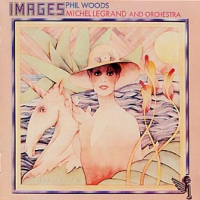 Phil Woods
Phil Woods Images
RCA, 1975
Ignore the wafty sleeve artwork, this is Legrand's second jazz masterpiece. The great Phil Woods first hooked up with Legrand in 1958, on the sessions for Legrand Jazz, and the pair continued to collaborate well into the 2000s. Recorded in London with a large orchestra arranged and conducted by Legrand, the sumptuous Images won a Grammy Award for Best Large Ensemble Jazz Album in 1976. It remains a highwater mark in Woods' catalogue. Legrand plays piano, wrote the scores and wrote or cowrote four of the eight tunes, which include a version of "The Windmills Of Your Mind." The other four tunes are Woods' "Nicole," Leon Russell's "A Song For You," Roger Nichols' "We've Only Just Begun" and Claude Debussy's "Clair De Lune." Legrand's 14-minute mini-suite title track (check the YouTube below) concludes a classy set and Woods, whether full-throttle or caressing, makes the most of it all. This is the kind of affirmatory album about which people say "It saved my life" and when they do so, one believes them. Another recommended 1975 Legrand and Woods collaboration, this one recorded in New York with a small group and an all-Legrand set list, is Recorded Live At Jimmy's (RCA), which has George Davis on guitar, Ron Carter on bass and Grady Tate on drums.
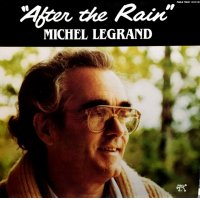 Michel Legrand
Michel Legrand After The Rain
Pablo, 1983
Recorded on a single day in May 1982 in RCA's New York studio, After The Rain has the real-time feel of a well-recorded live album. Legrand leads a stellar septet with a front line of Phil Woods on alto and clarinet, Zoot Sims on tenor and Joe Wilder on trumpet and flugelhorn, plus Gene Bertoncini on guitar, Ron Carter on bass and Grady Tate on drums. The set list is six lesser-known Legrand ballads, on which his arrangements leave plenty of room for soloists. On the rear sleeve, Legrand signs the album off thus: "Jazz is the best of all nourishments. It feeds the creative spirit like nothing else can. It is a fantastic adventure, an exciting game of giving and taking and exchanging musical ideas with brothers and friends. When the conditions are right, it is possible to achieve a level of rapport that is nowhere else to be found in music or, for that matter, [elsewhere] in art." The conditions were right that day and in that company. After The Rain is true balm for the soul.
 Michel Legrand
Michel Legrand The Warm Shade Of Memory
Evidence, 1996
Something of an anomaly in the Evidence catalogue, which is best known in this parish for its terrific Sun Ra and Pharoah Sanders reissues, the release of The Warm Shade Of Memory, within months of its recording, testifies to the label's commitment to substance over style. The album is perhaps Legrand's finest trio recording. It is, anyway, near perfect. The lineup is completed by bassist Marc-Michel Le Bevillon and drummer Umberto Pagnini; Toots Thielemans adds harmonica to two tracks and Legrand adds his vocals (an acquired taste, but here only brief) to another couple. The album revolves around a 12-minute medley from Legrand's soundtrack for the movie Les Demoiselles De Rochefort (1967) and a seven-minute one from Peau D'Âne (1970). So the nostalgia referencing "The Warm Shade Of Memory," which closes the set, is appropriate. Slow and pensive, it receives a glowing treatment. Legrand had by this time nothing left to prove as a musician and, while his pianism retained occasional rococo flourishes, he is mostly concerned with digging deeper into the melodic and harmonic possibilities of the material to hand, saying more by doing less. Penultimate track "Je Vivrai San Toi" (I Will Say Goodbye) reinforces the elegiac mood—which, happily, was premature, for Legrand did not leave town until 2019.
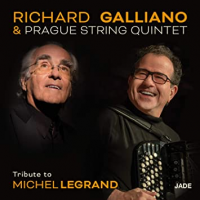 Richard Galliano
Richard Galliano Tribute To Michel Legrand
Jade, 2019
Recorded five months after Legrand passed and rush released before the end of the same year, Richard Galliano's Tribute To Michel Legrand might well have been among several more Legrand tribute albums had not the world been overtaken by events in early 2020. Latecomers may still be in the pipeline. Lead instrument the accordion might signal Richard Galliano's album as stereotypically Gallic, but it is actually very good, authentic even. We should not be surprised. Galliano has a jazz sensibility as well as a chanson one, rather like Legrand himself, and he is on home ground. There are twelve Legrand originals (plus two by Galliano), including greatest hits such as "I Will Wait For You," "The Windmills Of Your Mind," "The Summer Knows" and "You Must Believe In Spring," along with lesser known tunes. The arrangements for the Prague String Quintet are unfussy and effective.
 Michel Legrand
Michel Legrand Le Cinema De Michel Legrand Nouvelle Vague
Universal, 2006
No library of Legrand's music would be complete without at least one collection of his film music. Most of the available CD compilations concentrate on the mainstream Hollywood hits, but Le Cinema De Michel Legrand Nouvelle Vague focuses instead on the French films with which Legrand founded his filmic reputation in the early 1960s. There are selections from François Reichenbach's L'Amerique Insolite (1960), Jacques Demy's Lola (1961), Jean-Luc Godard's Un Femme Est Un Femme (1961) and Vivre Sa Vie (1962), Agnès Varda's Cleo De 5 A 7 (1962), Demy, Godard, Philippe de Broca, Claude Chabrol, Sylvain Dhomme, Max Douy, Eugène Ionesco, Édouard Molinaro and Roger Vadim's Les Sept Péchés Capitaux (1962), Demy's La Baie Des Anges (1963) and Godard, Chabrol, Ugo Gregoretti, Hiromichi Horikawa and Roman Polanski's Les Plus Belles Escroqueries Du Monde (1964). And that's a wrap.
Tags
Building a Jazz Library
Michel Legrand
Chris May
Stan Getz
Phil Woods
Miles Davis
Ronnie Scott
Blossom Dearie
Les Blue Stars
George Shearing
John Coltrane
Bill Evans
ben webster
Donald Byrd
Art Farmer
Herbie Mann
Paul Chambers
Hank Jones
George Duvivier
Ernie Royal
Jimmy Cleveland
Fats Waller
Django Reinhardt
Tadd Dameron
Billy Strayhorn
Guy Pedersen
Gus Wallez
Eddy Louiss
Eddie Sauter
Burt Bacharach
George Davis
Ron Carter
Grady Tate
Zoot Sims
Joe Wilder
Gene Bertoncini
Sun Ra
Pharoah Sanders
Marc-Michel Le Bevillon
Umberto Pagnini
Toots Thielemans
Richard Galliano
Yusef Lateef
PREVIOUS / NEXT
Support All About Jazz
 All About Jazz has been a pillar of jazz since 1995, championing it as an art form and, more importantly, supporting the musicians who make it. Our enduring commitment has made "AAJ" one of the most culturally important websites of its kind, read by hundreds of thousands of fans, musicians and industry figures every month.
All About Jazz has been a pillar of jazz since 1995, championing it as an art form and, more importantly, supporting the musicians who make it. Our enduring commitment has made "AAJ" one of the most culturally important websites of its kind, read by hundreds of thousands of fans, musicians and industry figures every month.









